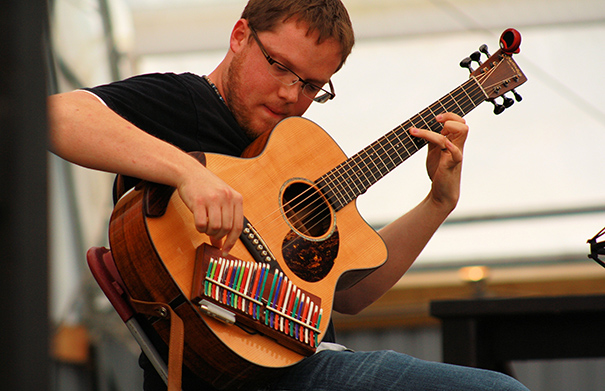Kalimbatar: Trevor Gordon Hall combines clean and clear guitar chords with a kalimba in this album, his fifth release. He is a master guitarist and the perfect partner for this instrument.
Unlike the piano, kalimba notes are arranged in a bi-linear fashion, with lower octave notes on the right side and higher ones on the left. This creates interesting and unique chords.
Harmonic Melodies from an Ancient World
Trevor Gordon Hall is a Philadelphia-based guitarist who, in 2010, began experimenting with the idea of pairing an acoustic guitar with a kalimba (an African thumb piano). He redesigned and fine-tuned a version that sits flat on top of the guitar and spans 2 octaves. This instrument combination, dubbed the Kalimbatar, opened up new approaches and sounds for him.
By the early 14th century, composers had begun to eschew the strict rules of the ancient modes in favor of a more flexible approach. One result was the emergence of musical harmony, which at first consisted simply of adding an additional voice that paralleled the original melody at the interval of a third, as in the example of English organum or gymel.
Richard Heath, a development engineer with degrees in systems science and computer-aided design, is the author of four books including Sacred Number and the Origins of Civilization. He lives near Cardigan, Wales.

Entelechy
The concept of entelechy (from the Greek enteles, “perfect” and ekheia, “to have”) is at the heart of Aristotle’s philosophy. It distinguishes the actual from the merely potential. For Aristotle, everything that is real has a form which completes it.
It is the form of a butterfly that gives it wings, not its mere material makeup. And it is the entelechy, or internal perfecting, of a human being that makes it able to feed itself, grow and reproduce and to sense and rationalize.
Driesch’s entelechy doctrine was meant to explain how the principle of organic systematics could overcome the augmentation of entropy that only applies to physico-chemical systems. He also used it in connection with his vitalistic biology. But his logical formulation was flawed.
Turning Ruts Into Grooves
Sometimes you get into a groove and just want to keep playing. And other times, you find yourself in a rut and need to work hard to get out of it.
For deep ruts, you might need to use the spade fork to loosen the soil a little more before filling the rut. This can be time consuming, but it will make the new spot easier to plant, and it will help prevent that rut from getting compacted again in the future.
Guitarist Trevor Gordon Hall captures the feeling of a groove perfectly on his song “The Meeting at the Window” with jangly chords, subtle pervasive effects, and bright tone (he plays a Kalimbatar, the only instrument of its kind). Listen to it here.
Short Story
On this album, Trevor Gordon Hall doesn’t settle into a creative rut. Complex instrumental passages like those on Midnight and Raining and Turning Ruts Into Grooves crank up the energy level, but his quiet and lyrical piece Short Story brings the recording to a peaceful conclusion.
In a short story, the characters reveal their deepest thoughts, motives, sentiments and emotions. Often, the theme is built around a subject such as death or hope and how that subject impacts the human condition, society or life. It’s important to keep in mind that the theme should be stated as a broad observation about human nature.
A short story requires deftness and clarity and a strong point of view. By utilizing these concepts, you can create a successful short story that engages the reader.


